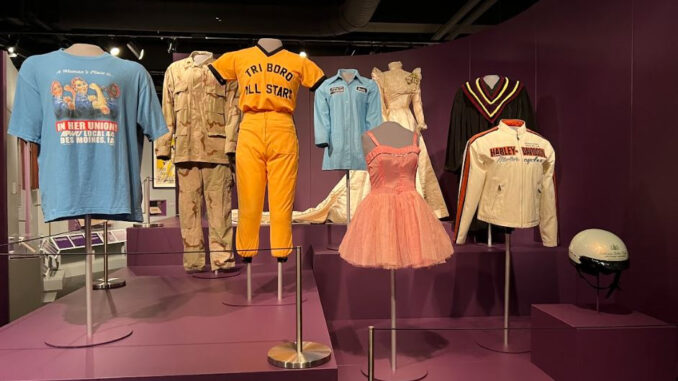
Emily Fritz | A&E Editor
What comes to mind when you think of “a woman’s place?” Is it the punchline of a joke about making sandwiches? Perhaps you think about the centuries worth of homemaking and child rearing that captures the dated day-to-day life of women in the 1800s. The Heinz History Center is “flipping the script” as they showcase stories of women in multiple facets of life, coexisting with the archaic cult of domesticity.
“A Woman’s Place: How Women Shaped Pittsburgh” is a new exhibit that presents us with the dynamic histories of women from Western Pennsylvania who have shaped the Steel City, the country and the world through their actions and advocacy.
Appropriately dubbed “the people’s museum,” the history center is well-known for its showcase of regional stories and historical people, but the temporary exhibit became available for patrons to enjoy on March 23.
“From pioneering investigative journalism to leading their country to Olympic gold, Western Pennsylvania women have made an immeasurable impact in America, but too often, their stories have been overlooked,” read a news release from the museum.
Lined up at the entrance was a period wedding dress, judicial robes and a combat uniform alongside an auto mechanic’s work shirt, a 1965 Tri-Boro All Stars softball uniform, a Harley-Davidson motorcycle jacket and a pink tutu dance costume.
The exhibit contains more than 250 artifacts, including immersive and interactive elements, archive images, clothing and textile pieces and sketches in addition to the posters and buttons of women’s suffrage.
“I think it does a good job of encouraging people to think about all the different ways that someone can make an impact beyond those traditional old history definitions of industry and battle and capital and things like that,” said senior curator Leslie Przybylek.
Despite their extensive collection, Przybylek explained that while local efforts can hold some of the biggest impacts to cultural history, finding artifacts that reflected more private and personal stories was difficult.
Przybylek said that students from Duquesne University’s public history class were involved in the brainstorming of the collection, conducting interviews with local women and contributing oral histories in the video component near the end of the exhibit.
“[Dr. Jennifer Taylor was] the one who originally connected with us. We did a focus group conversation with some students, and there was a group from a class that also came here early on and visited the history center,” Przybylek said.
To help patrons immerse themselves in the histories, interactive components were available for hands-on education. While the ‘go bag’ of renowned journalist Nellie Bly was temporarily unavailable, attendees could pack their own using a creative puzzle game.
Pop culture pieces, including the iconic ‘Rosie the Riveter’ poster and its many adaptations, were on display as well, showcasing the stories of real Western Pennsylvanian women who worked the mills during World War II.
Peppered with questions that inspired deeper contemplation, Przybylek emphasized the idea that progress isn’t linear and people – including historical figures – should be viewed with a holistic lens.
“As we see today in the world around us, you can find a figure who has positive aspects to them and negative aspects to them,” Przybylek said. “There’s a range of ways that they interacted with those around them. And I think we’re really hoping that people take a little bit more of that engaged, critical eye into the project.”
Similarly, “A Woman’s Place” dispels the idea of a historical vacuum. Intersectionality was a large component in the history center’s discussion of women’s history with civil rights and disability advocacy. Conversely, advocacy for women’s rights did not always encompass every minority group.
“At times, it created some uncomfortable bedfellows and other times it created a really powerful bloc of people who were successful in working together,” Przybylek said.
Security employee Dawn Little said that she has seen an increase in foot traffic during her daily patrols since the exhibit’s opening.
“I think the whole thing is important just because it shows how women evolved from years ago until now,” Little said. “It’s amazing what they contributed to the society of the whole state of Pennsylvania and the world. It’s very interesting what we’ve done and where we’ve come from.”
At the end of the walkthrough, people could submit a card nominating a girl or woman that has made history, impacted the world or personally impacted the nominator’s life. Submissions included local business owners, women elects, educators, mentors and of course, mothers.
From the pool, the Heinz History Center will consider individuals for the title of “History Maker,” or those who “profoundly contribute to the innovative history and collective heritage of our region and represent a commitment to excellence that has defined our community,” according to their website.
The exhibit will continue until Oct. 6, bringing unique learning opportunities to patrons in the coming weeks, including “Women’s Journey in Journalism with Brooke Kroger” on May 5, “Leading by Example: Women’s Leadership in Law” on May 23 and “Keystone Stories: Uncovering the Legacies of Pennsylvania Women” on June 30.
General admission for the Heinz History Center can be purchased for $20 or $11 with a valid student ID.
“We see this exhibit as part of an ongoing conversation,” Przybylek said. “Think about other women and other stories in the community … reach out and let us know.”
